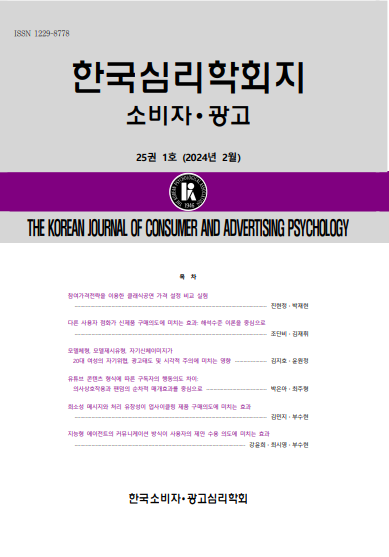open access
메뉴.png)
open access
메뉴 ISSN : 1229-8778
ISSN : 1229-8778
There is need of specific study on receiving and participating attitude of online postscript according to consumers’ characteristics because online postscript of purchased and used experience is acting increasingly important as criteria factor on purchase intention. This study analyzes empirically difference among consumers’ types of shopping value on receiving and participating attitude of online postscript after introducing internet shopping value as consumers’ characteristic valuable. First, in case of difference among consumers’ types of shopping value on receiving attitude of online postscript, three types show meaningful difference on degree of reliability and reception. Convenience and information seeking type is the highest and amusement seeking type is the lowest. In addition to, all of three types make most reference to contents of product quality or performance. Second, in case of difference among consumers' types of shopping value on participating attitude of online postscript, three types show meaningful difference on degree of writing one’s own online postscript but don’t show meaningful difference on degree of responding about other consumers’ questions. Convenience and information seeking type is the highest and amusement seeking type is the lowest in only degree of writing one’s own online postscript. In terms of simple percentage of three types about participating purpose, amusement seeking type and convenience and information seeking type are motivated by satisfaction of product or service but economic seeking type is motivated by saved money or discount.
김미주, 황의록 (2004). 인터넷쇼핑몰 이용자의 구전활동에 관한 연구. 한국유통학회 동계학술대회 발표 논문집, 34-45.
김성훈 (2003). 제품 관여도 및 제품지식에 따른 온라인 구전 정보 활용연구. 광고학연구, 4(1), 257-280.
김해룡, 최현국, 이문규 (2004). 인터넷 구전수용의 영향요인. 한국마케팅학회 추계학술대회발표논집, 45-255.
김화동 (2003). 소비자 쇼핑가치 추구유형별 인터넷 쇼핑몰의 선호요인 및 구매행동에 관한 연구. 상품학연구, 제29호, 259-275.
김화동 (2010). 인터넷 쇼핑 구매결정시 사용후기의 내용 방향성 형태별 수용도에 관한 연구: 제품 관여도 및 위험 지각정도에 따른 구매상황을 중심으로. 한국심리학회지: 소비자․광고, 11(3), 579-597.
매일경제 (2006. 4. 6). 트윈슈머 이미지 상품평 주목.
박종원 (2002). 온라인 시대의 소비자 행동. 법문사: 서울.
박철, 정수연 (2006). 온라인 소비자 구전에 대한 내용연구: 사이트 유형과 제품 유형에 따른 차이를 중심 으로. 광고연구, 제70호, 91-118.
박희정, 이문봉 (2002). 온라인채팅에서 아바타의 도입이 매체에 대한 사용자의 인지에 미치는 영향. 경영정보학연구, 12(4), 235- 250.
성영신, 박진영, 박은아 (2002). 온라인 구전정보가 영화 관람의도에 미치는 영향: 기대를 중심으로. 광고연구, 제57호, 31-52
윤준수 (1998). 인터넷의 커뮤니케이션 특성에 기반 한 혼합형(Hybrid) 지식관리시스템에 대한 연구: 인터넷의 정보과잉 공급에 따른 정보의 지식화 현상을 중심으로. 중앙대학교 대학원 박사학위논문.
안승원 (1998). 전자상거래의 소비자 구매행태분석에 관한 연구. 경영정보학연구, 제9권, 134-150.
양 윤, 조문주 (2000). 구전 커뮤니케이션이 소비자 태도변화에 미치는 영향. 광고학연구, 11(3), 7-34.
이은영 (2004). 커뮤니티 특성과 사이트 특성이 온라인 구전의 수용과 확산에 및는 영향에 관한 연구. 한국마케팅학회 추계학술대회 발표논문집, 305-325.
이은영, 이태민 (2005). 온라인 환경에서의 정보특성이 구전효과에 미치는 영향에 관한 연구: 소비자 제품 지식의 조절효과를 중심으로. 광고학연구, 16(2), 7-33.
이은재, 심완섭 (2007). 인터넷쇼핑 이용후기 메시지의 신뢰평가와 구매시점 및 구매 후 행동특성 연구. e-비지니스연구, 8(3), 155-170.
이철선 (2003). 가상공동체에서 플레이밍(Flaming)에 관한 연구. 마케팅연구, 18(1), 3-30.
이학식, 김영, 정주훈 (1999). 실용적/쾌락적 쇼핑가치와 쇼핑만족: 구조모델의 개발과 검정. 경영학연구, 28(2), 505-538.
이현선, 리대룡 (2004). 구전으로서 온라인 사용후기의 효과에 관한 연구. 홍보학연구, 8-2, 234-268.
임채운, 편해수 (2000). 소매점의 서비스 유형이 소비자의 쇼핑가치와 쇼핑만족에 미치는 영향. 소비자학 연구, 11(3), 169-192.
전달영, 경종수 (2000). 인터넷 쇼핑몰에서 쇼핑가치와 쇼핑애호도의 결정요인: 엔터테인먼트 상품을 중심 으로. 한국유통학회 춘계학술대회발표논문집, 177-185.
전우영, 정현주 (2006). 인터넷 쇼핑에서 사용후기가 제품에 대한 평가와 구매의도에 미치는 영향: 성차의 역할을 중심으로. 한국심리학회지: 소비자․광고, 7(1), 113-129.
황의록, 김창호 (1995). 구전커뮤니케이션에 관한 문헌. 광고연구, 제26호, 55-84.
최은영 (2004). 인터넷 쇼핑몰 의류 상품평 내용과 소비자 인식에 관한 연구. 복식문화연구, 12(6), 84-998.
통계청 (2010). 2010년 연간 및 4/4분기 전자상거래 및 사이버쇼핑동향 조사결과.
Schindler, R. M. & Bickart, B. (2002). Expanding the Scope of Word of Mouth: Consumer-to- Comsumer Information on the Internet. Advances in Consumer Research, 29, 428-430.
Bloch, P. H., Sherrell, D. L., & Ridgway, N. M. (1986). Consumer Search: An Extended Framework. Journal of Consumer Research, 13(June), 119-128.
Chatterjee, P. (2001). Online Review: Do Consumer Use Them?. Advances in Consumer Research, 28, 129-133.
Chevalier, J. A. & Mayzlin, D. (2003). The Effects of Word of Mouth on Sales: Online Book Reviews, Working Paper #10148., national bureau of Economic Research, http://www.nber.org/papers/ w10148.
Godes, D. & Mayzline, D. (2004). Using Online Conversations to Study Word of Mout Communication. Working Paper, Harvard University Business School.
Henning-Thurau, T. & Walsh, G. (2003). Electronic word-mouth: Motives for and Consequences of Reading Customer Articulations on the Internet. International Journal of Electronic Commerce, 8(2), 51-74.
Hoffman, Donna L. & Novak, Tomas P. (1996). A New Marketing Paradigm for Electronic Commerce. The Information Society, Special Issue on Electronic Commerce, 13(Jan-Mar), 50-68.
Jarvenpaa, Srikka L. & Todd, Peter A. (1997). Is There a Future Foretailing on the Internet? Electronic Marketing and Consumer, 139-154.
Joinson, A. N. (1997). Anonymity, Dsinhibition, and Social Desirability on the Internet. Pape Presented at The Bps Social Section Annual Conference, University of Sussex, England.
Keisler, S. (1997). Culture of internet. Mahwah, NJ: Lawrence Erlbaum Associates.
Midgley, David F. (1983). The Dimensions of Advertising Involvement. Advanced in Consum Research, 8, 25-30.
Parasuraman, A., Zeithaml V. A., & Berry L. L. (1988). A Communication and Control Process in the Delivery of Service Quality. Journal of Marketing, 52, 12-40.
Westbrook, R. A. & Formell, C. (1979). Partterns of Information Source Usage among Durable Goods Buyers. Journal of Marketing Research, 16, 303-312.